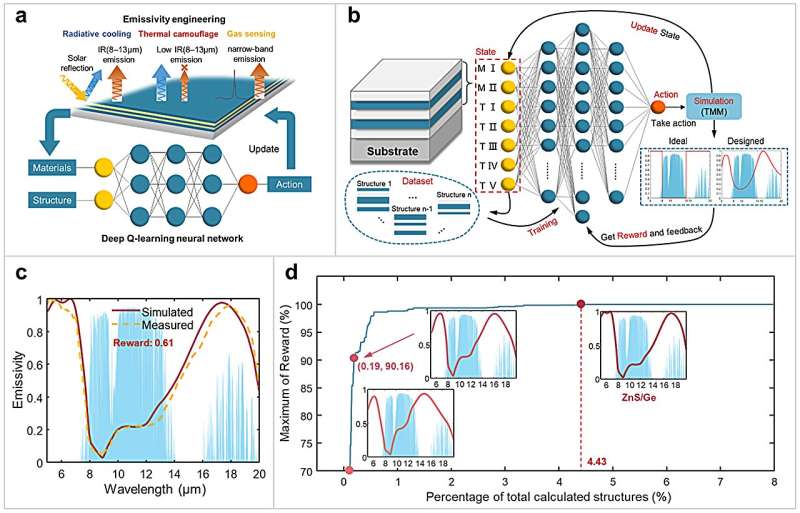This article has been reviewed according to Science X's editorial process and policies. Editors have highlighted the following attributes while ensuring the content's credibility:
fact-checked
proofread
General deep learning framework for emissivity engineering

Wavelength-selective thermal emitters (WS-TEs) have been frequently designed to achieve desired target emissivity spectra, as in typical emissivity engineering, for broad applications such as thermal camouflage, radiative cooling, and gas sensing, etc.
However, previous designs required prior knowledge of materials or structures for different applications, and the designed WS-TEs usually vary from application to application in terms of materials and structures, thus there is no general design framework for emissivity engineering across different applications. Moreover, previous designs fail to tackle the simultaneous design of both materials and structures, as they either fix materials to design structures or fix structures to select suitable materials.
In a new paper published in Light: Science & Applications, a team of scientists, led by Professor Run Hu from School of Energy and Power Engineering, Huazhong University of Science and Technology, China, and coworkers have proposed a general deep learning framework based on the deep Q-learning network algorithm (DQN) for efficient optimal design of WS-TEs across different applications.
Employing this framework, they designed three multilayer WS-TEs for thermal camouflage, radiative cooling and gas sensing, respectively. The materials of the WS-TEs are autonomously selected by DQN algorithm from the same common material library according to the target emissivity spectra of different applications, and the structural parameters are optimized simultaneously.
The three designed WS-TEs all present excellent performance, which are experimentally fabricated and measured and the actual emissivity spectra are matched well with the target. As such, the proposed framework is demonstrated to be efficient in achieving reverse design of WS-TEs within a vast optimization design space. More important, it offers a general framework for emissivity engineering across different applications and paves the way for the efficient design of nonlinear optimization problems beyond thermal metamaterials.
The proposed framework is a general design approach for emissivity engineering that is highly scalable across the design parameters of the WS-TMs, including material, structure, dimension, and target function. The core of the framework is the DQN algorithm that can receive various design parameters and output a decision to update those parameters. In the continuous iterative update, DQN gradually learns how to make appropriate decisions to finally achieve the optimal design.
"The merits of the deep Q-learning algorithm are that it can (1) offer a general design framework for WS-TEs beyond one-dimensional multilayer structures; (2) autonomously select suitable materials from a self-built material library and (3) autonomously optimize structural parameters for the target emissivity spectra," state the researchers.
"Considering the eight available materials, this structural configuration leads to 8×7×505= 1.75×1010 potential candidate structures. The demand of simultaneous material selection and structure optimization, together with the sheer volume of optimization space, renders manual design impractical and presents significant challenges to conventional machine learning methods," they added.
"Additionally, the input parameters of the DQN framework are highly flexible in materials, structures, dimensions, and the target functions, offering a general solution to other nonlinear optimization problems beyond emissivity engineering," the scientists said.
More information: Shilv Yu et al, General deep learning framework for emissivity engineering, Light: Science & Applications (2023). DOI: 10.1038/s41377-023-01341-w
Provided by TranSpread




















